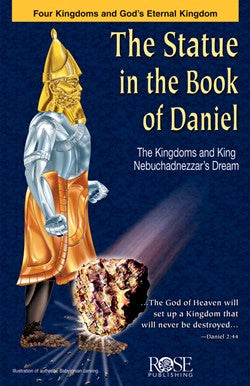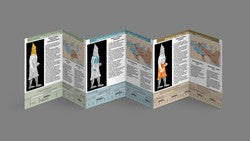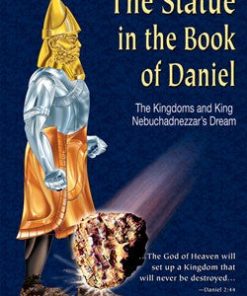Pamphlet – Statue in the book of Daniel Rose Publishing
$ 4,99 $ 2,99
Pamphlet – Statue in the book of Daniel
Enjoy Having a Highly Visual Overview of the Statue in the Book of Daniel Packed with Time Lines, Maps, Charts, and More!
The Statue in the Book of Daniel pamphlet ventures into the fascinating dream of King Nebuchadnezzar in Daniel 2 and Daniel’s vision in Daniel 7. This bestselling, full-color pamphlet includes:
- A full-color illustration of the statue (based on an authentic Babylonian carving of the era)
- Simple overviews exploring each of the statue’s four parts, as well as the four kingdoms they represent
- Maps of ancient civilizations outlining the geographical areas of the relevant kingdoms
- A time line of events and rulers
- A comparison chart help explain the statue’s parts and their meaning
12 panels, fits into most Bibles, 8.5 x 5.5 inches, unfolds to 33” long.
The Statue in the Book of Daniel is an excellent resource for presenting Daniel’s prophecy of God’s everlasting Kingdom. Daniel’s interpretation draws correlations between the elements of the statue:
- The Head of Fine Gold
- The Chest and Arms of Silver
- The Belly and Thighs of Bronze
- The Feet of Iron and Clay
- The rock—not cut out by human hands—which struck and felled the statue
What does the statue represent in King Nebuchadnezzar’s dream in the second chapter of Daniel? What is it saying about earthly empires and heavenly kingdoms? The Statue in the Book of Daniel pamphlet describes the meaning of the Head of Fine Gold, Chest and Arms of Silver, Belly and Thighs of Bronze, and Feet of Iron and Clay. A map of the ancient world provides context for the kingdoms that are represented by the statue segments, and a time line reveals the rise and fall of kingdoms between 600 BC to 100 AD. Daniel’s interpretation speaks to the Scriptural truth that rulers and empires come and go, but God’s kingdom, ruled by the Son of Man, will be everlasting.
The Statue in the Book of Daniel also provides information on the most powerful nations in the Middle East represented in Daniel’s dream:
- Babylonia
- Medo-Persia
- Greece
- A Divided Kingdom (often considered Rome)
A chart compares the remarkable similarities between King Nebuchadnezzar’s dream in Daniel 2 with Daniel’s vision in Daniel 7. Here is a sample from the chart:
Nebuchadnezzar’s Dream (Daniel 2):
- Head of the Statue
- Chest and Arms of Statue
- Belly and Thighs of Statue
- The Feet of Iron and Clay
Daniel’s Vision (Daniel 7):
- Vision of Beasts — Lion
- Vision of Beasts — Bear
- Vision of Beasts — Leopard
- Visions of Beasts — Beast with 10 horns
An illustration of the statue is based on an authentic Babylonian carving. Comparisons between each part include bulleted observations with interesting facts or connections to other Scripture references.
A time line from 600 BC to 100 AD reveals the events related to the ruling kingdoms that clarify the interpretations. Events include:
- The Babylonian Kingdoms and their rulers during biblical times
- The fall of Babylonia to Darius the Mede, who was succeeded by Cyrus the Great.
- Alexander the Great’s conquest of Persia and its fulfillment of prophecy
- The rise of Rome and the Caesars.
Fast Shipping and Professional Packing
We offer a broad range of shipping options due to our long-standing relationships with UPS, FedEx and DHL. Our warehouse personnel are highly skilled and will pack your goods in accordance to our exact and precise specifications. Prior to shipping, your goods are carefully examined and safely secured. Each day, we ship to thousands of clients in many countries. This shows our commitment to be the largest online retailer on the planet. Warehouses and distribution centers are found in Europe as well as the USA.
Note: Orders that contain more than one item will be assigned a different processing period for each item.
Before shipping, all ordered items will be thoroughly examined. Most orders are now shipped within 48 hours. The time to deliver varies from 3-7 days.
Returns
We don't manage the stock at our factory and warehouse. Actual stock levels may fluctuate at any time. Be aware that your order is out of stock once the order has been placed.
Our policy lasts for thirty days. If it's been more 30 days since you've purchased your item, we unfortunately can't give you a full exchange or refund.
You are able to return a product in the event that it is not used and in the same condition the day you received it. The item must be in the original packaging.






































